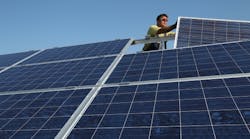For all the upbeat forecasts about the growth of solar power, this is a punishing year for the industry. And it won’t improve any time soon.
SunEdison Inc., the world’s biggest clean-energy company, is bankrupt. Yingli Green Energy Holding Co., once the top panel maker, warned it might be inching toward default. A Bloomberg index of 20 major solar companies has plunged more than 30% this year, with every member in the down column. Solar shares are performing even worse than coal stocks.
The tumult comes as installations soar and demand for clean energy reaches records. Falling prices, renewed U.S. tax breaks and the Paris climate deal are fueling sales worldwide. That’s been eclipsed by investors’ concerns that the debt-fueled strategies employed by SunEdison and Yingli are endemic to the industry.
“They call it the solar coaster for a reason,” said Nancy Pfund, managing partner of DBL Partners and a SolarCity Corp. director. With so much happening, both positive and negative, “it’s been hard for investors to follow.”
Solar turbulence isn’t new. The past decade has been marked by booms, busts and failures that included Suntech Power Holdings Co. and Q-Cells SE, both of whichwere once the world’s biggest panel producers.
Despite the ups and downs, the general trend is up. Developers will install 48.4 gigawatts of solar by the end of 2020, more than double the amount in the prior five years, according to Bloomberg New Energy Finance. Problems at a few major companies don’t necessarily carry over to the rest. At least they shouldn’t.
‘More Perception’
“It’s more perception than true fundamentals,” said Angelo Zino, analyst at S&P Global Market Intelligence. “The fundamentals continue to improve.’’
That means there may be bargains, said Leslie D. Biddle, a partner at Serengeti Asset Management, a $1.5 billion New York hedge fund that specializes in distressed debt: “At the moment, solar equities are a buying opportunity.’’
Solar investors remain rattled, with legitimate questions about leverage and financing. The markets are looking for proof that companies can make and install panels profitably.
“Investors lost a lot of money on SunEdison -- and quickly,” said Carl Weatherley-White, former president of developer Lightbeam Electric Co. “They’re nervous. We’ll need to see a steady quarter or two of success by the public companies.”
Against that expectation, the drumbeat of bad news continues. Abengoa SA, a builder of solar-thermal power plants, is seeking investor support for a 9.4 billion-euro ($10.71 billion) debt restructuring plan to avoid becoming Spain’s largest corporate failure. And hedge fund manager Jim Chanos said SolarCity, which is down more than 50% this year, will face more “financial trouble” in 2016, in part because the largest U.S. rooftop solar provider loses money on every installation.
While there are a variety of reasons Wall Street has soured on solar, the conversation always comes around to SunEdison, the industry’s biggest-ever failure, which cited $16.1 billion in liabilities when it sought protection from creditors April 21.
Buying Binge
The company spent billions on a debt-fueled buying binge, which peaked in July when it announced plans to acquire the rooftop installer Vivint Solar Inc. for $2.2 billion. The deal prompted analysts to take a closer look at SunEdison’s finances, revealing an overleveraged, overcomplicated behemoth that’s financially entangled with two publicly traded holding companies.
“It is impossible for people not to be concerned when the leader nosedives like that,” said Shawn Kravetz, founder of Esplanade Capital LLC, a Boston fund manager with a decade of investing experience in solar.
SunEdison’s decline shows another unusual trend. In past boom-bust cycles, the carnage was within specific parts of the solar industry; sometimes manufacturers, other times developers. This time, it’s both.
With SunEdison in bankruptcy, the industry’s one-time leading panel-maker is teetering toward default. Yingli, which hasn’t reported a quarterly profit since 2011, has 1.4 billion yuan ($214.82 million) of notes due on May 12, and said in April it would be “very difficult” to make the payment.
Financial problems are hardly isolated to the marquee names, said John Berger, chief executive of the closely held residential solar installer Sunnova Energy Corp. Many solar companies have “growth-at-any-cost’’ business models that are neither profitable nor sustainable.
“When you don’t generate the returns for the equity holders that they are expecting, you don’t make money,” Berger said. “There are a lot of management teams in this sector that haven’t figured that out.’’
Even profitable companies are revisiting business models. First Solar Inc., the biggest U.S. solar manufacturer, detailed in April a plan to focus on future growth from making and selling high-efficiency solar panels rather than large power plants. A few weeks later it announced plans to replace its CEO. Its shares are down more than 20% this year.
Ethan Zindler, a New Energy Finance analyst, said the economics of solar economics have never been better, given low equipment costs and surging demand: “But that’s not reflected in the share prices.”
By Joe Ryan and Brian Eckhouse



